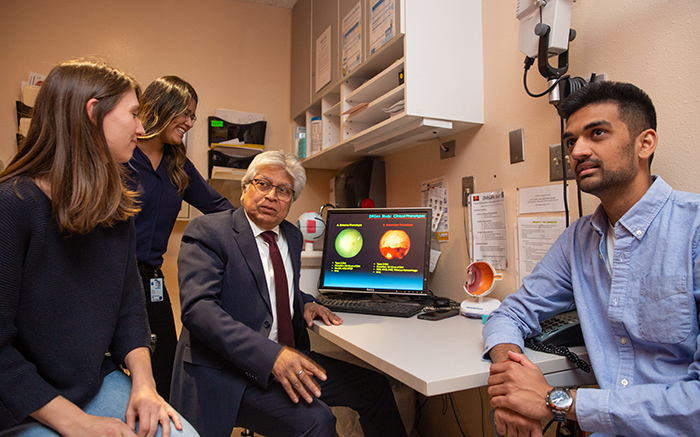Preparing for Disaster: UNM Hospital Participates in Region-Wide Emergency Training

Seeking Insight
UNM Researchers Search for Genetic Clues in Diabetic Retinopathy
Diabetic retinopathy is a leading cause of blindness that presents in diverse ways across different groups of people. In search a better understanding of these differences, Arup Das, MD, PhD, has a hunch it all comes down to genes.
Das, a Distinguished and Regents' Professor in The University of New Mexico Department of Ophthalmology & Visual Sciences, leads the five-year $2.8 million Diabetic Retinopathy Genomics (DRGen) Study in collaboration with Boston-based Joslin Diabetes Center, a Harvard Medical School affiliate.
Now in its fourth year, the National Eye Institute-funded study is looking for hidden genetic factors that influence the course of the disease, which robs sufferers of vision by damaging the light-sensing retina in the back of the eye.
The researchers collected blood samples from 450 patients at UNM and at Joslin, Das says. Most of the New Mexico patients were Hispanic and American Indians, while the Boston samples were primarily collected from Caucasians.
The blood samples are undergoing whole exome sequencing, a relatively new genome study technique that focuses only on those stretches of DNA that code for proteins. “We are in the process of analyzing the results,” Das says.
One arm of the study is looking at a poorly understood phenomenon in some diabetes patients.
“It is well known that the severity of diabetic retinopathy increases as somebody’s diabetes worsens,” Das says. “Here, as well as in Boston, we found a very small number of patients, who despite longer duration of diabetes – maybe 20 years or 30 years – have no eye disease. What is protecting them, whereas thousands and thousands of people are getting blindness in the eye?”
Another part of the study focuses on better understanding two distinct forms of the disease. One, called proliferative diabetic retinopathy, is characterized by an overgrowth of new blood vessels, which leads to bleeding in the eye and loss of vision.
In the other type – diabetic macular edema – “the blood vessels leak plasma, and as a result, the retina becomes thickened, swollen and the patient loses vision,” Das says. “That is the No. 1 cause of blindness.
Early results reveal that macular edema is more prevalent in Hispanic patients, but uncommon in American Indians, who are more likely to experience proliferative retinopathy, he says. “This kind of ethnicity risk factor most likely has its basis in genetics,” he says.
A third area of research seeks to better understand how people respond to first-line treatment with anti-VEGF medications, which are injected into the eye to slow progression of the disease.
About a third of patients respond well to the therapy, which requires multiple injections, another third respond poorly or not at all, and the rest have an intermediate response.

If we knew beforehand with a genetic test who responds well to the drugs and who will not respond well, we could prevent all these unnecessary injections in the poor responders
“We found some rare genetic variants related to the inflammation pathway in these patients that may be causing them to be resistant to this anti-VEGF treatment,” Das says. “These results need to be confirmed in larger sample sizes of patients.”
These findings could have a bearing on patient care and lead to “personalized medicine,” he says. “If we knew beforehand with a genetic test who responds well to the drugs and who will not respond well, we could prevent all these unnecessary injections in the poor responders.”
The DRGen study slowed to a near-standstill in 2020 due to COVID-19 pandemic restrictions, Das says, but it is now back on track as researchers hope to break new ground in caring for patients with the disease.
“Our goal is to develop novel biomarkers and therapeutic targets so that we can diagnose the patients early and modify treatments accordingly,” he says.